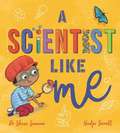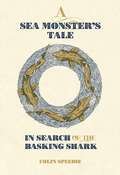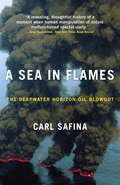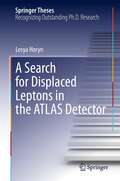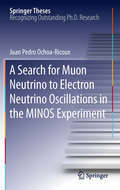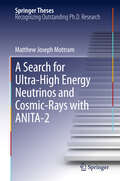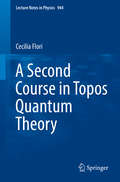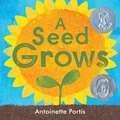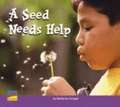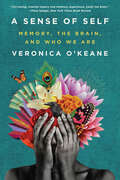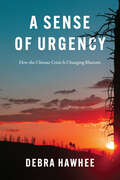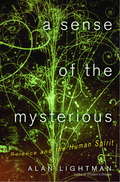- Table View
- List View
A Scientist Like Me
by Dr Shini SomaraElectrifying illustrations and an empowering story combine to introduce young readers to the world of science, observation and problem-solving.There's NOTHING that Ruben doesn't find fascinating. Why do leaves change colour? What makes ice cream melt? On a trip to the beach with his mum, he discovers how the world works and the brilliant scientists who have helped us understand it. Maybe he can try out some awesome experiments and become a scientist too?With pages encouraging kids to try out their very own science experiments such as germinating seeds and writing with invisible ink, this brilliant picture book written by scientist and TV presenter Dr Shini Somara unlocks a love of science and celebrates women in STEM.The second book in an exciting new series. Also available:- An Engineer Like Me- A Coder Like Me- A Mathematician Like Me
A Scientist at the Seashore
by James S. Trefil"A marvelous excursion from the beach to the ends of the solar system . . . captivating."--The New York Times"So easy to understand yet so dense with knowledge that you'll never look at waves on a beach the same way again."--San Francisco Chronicle"One of the best popular science books."--The Kansas City Star"Perfect for the weekend scientist."--The Richmond News-LeaderA noted physicist and popular science writer heads for the beach to answer common and uncommon questions about the ocean. James S. Trefil, author of Dover Publications' The Moment of Creation: Big Bang Physics from Before the First Millisecond to the Present Universe, explains why the sea is salty, how bubbles form on the water's surface, where waves come from, and other curiosities of the marine world. Dr. Trefil draws upon his unique gift for clarifying complex scientific principles and the theories behind them to present a narrative that is clear, accessible, and utterly compelling.
A Sea Monster's Tale: In Search of the Basking Shark (Wild Nature Press)
by Colin SpeedieThere are few marine creatures as spectacular as the Basking Shark. At up to 11 metres in length and seven tonnes in weight, this colossal, plankton-feeding fish is one of the largest in the world, second only to the whale shark. Historically, Basking Sharks were a familiar sight in the northern hemisphere – off the coasts of Norway, Scotland, Ireland, Canada and the USA, for example. In an 18th Century world without electricity, they became the focus of active hunting for their huge livers containing large amounts of valuable oil, primarily used in lamps.Catch numbers were small enough to leave populations largely intact, but during the 20th Century a new breed of hunter joined the fray, some driven as much by a need for adventure as for financial gain. With improved equipment and experience, they exploited the shark on an industrial scale that drastically reduced numbers, leading to localised near-extinction in some areas.From the 1970’s onward a new generation took to the seas, this time with conservation in mind to identify where the shark might still be found in the waters around the British Isles, employing new technologies to solve long-standing mysteries about the behaviour of this elusive creature. Using the best of both old and new research techniques, the case was built to justify the species becoming one of the most protected sharks in the oceans.Today, the Basking Shark is a much-loved cornerstone of our natural heritage. There are positive signs that the population has stabilised and may even be slowly recovering from the damage of the past, proving that timely conservation measures can be effective. Join us on a journey amidst wild seas, places, people and conservation history in the battle to protect this iconic creature – a true sea monster’s tale.
A Sea in Flames: The Deepwater Horizon Oil Blowout
by Carl SafinaCarl Safina has been hailed as one of the top 100 conservations of the 20th century (Audubon Magazine) andA Sea in Flamesis his blistering account of the months-long manmade disaster that tormented a region and mesmerized the nation. Traveling across the Gulf to make sense of an ever-changing story and its often-nonsensical twists, Safina expertly deconstructs the series of calamitous misjudgments that caused theDeepwater Horizonblowout, zeroes in on BP’s misstatements, evasions, and denials, reassesses his own reaction to the government’s crisis handling, and reviews the consequences of the leak-and what he considers the real problems, which the press largely overlooked. Safina takes us deep inside the faulty thinking that caused the lethal explosion. We join him on aerial surveys across an oil-coated sea. We confront pelicans and other wildlife whose blue universe fades to black. Safina skewers the excuses and the silly jargon-like “junk shot” and “top kill”-that made the tragedy feel like a comedy of horrors-and highlighted Big Oil’s appalling lack of preparedness for an event that was inevitable. Based on extensive research and interviews with fishermen, coastal residents, biologists, and government officials,A Sea In Flameshas some surprising answers on whether it was “Obama’s Katrina,” whether the Coast Guard was as inept in its response as BP was misleading, and whether this worst unintended release of oil in history was really America’s worst ecological disaster. Impassioned, moving, and even sharply funny,A Sea in Flamesis ultimately an indictment of America’s main addiction. Safina writes: “In the end, this is a chronicle of a summer of pain-and hope. Hope that the full potential of this catastrophe would not materialize, hope that the harm done would heal faster than feared, and hope that even if we didn’t suffer the absolutely worst-we’d still learn the big lesson here. We may have gotten two out of three. That’s not good enough. Because: there’ll be a next time. ” From the Hardcover edition.
A Sea of Glass: Searching for the Blaschkas' Fragile Legacy in an Ocean at Risk (Organisms and Environments #13)
by Drew HarvellIt started with a glass octopus. Dusty, broken, and all but forgotten, it caught Drew Harvell's eye. Fashioned in intricate detail by the father-son glassmaking team of Leopold and Rudolf Blaschka, the octopus belonged to a menagerie of unusual marine creatures that had been packed away for decades in a storage unit. More than 150 years earlier, the Blaschkas had been captivated by marine invertebrates and spun their likenesses into glass, documenting the life of oceans untouched by climate change and human impacts. Inspired by the Blaschkas' uncanny replicas, Harvell set out in search of their living counterparts. In A Sea of Glass, she recounts this journey of a lifetime, taking readers along as she dives beneath the ocean's surface to a rarely seen world, revealing the surprising and unusual biology of some of the most ancient animals on the tree of life. On the way, we glimpse a century of change in our ocean ecosystems and learn which of the living matches for the Blaschkas' creations are, indeed, as fragile as glass. Drew Harvell and the Blaschka menagerie are the subjects of the documentary Fragile Legacy, which won the Best Short Film award at the 2015 Blue Ocean Film Festival & Conservation Summit. Learn more about the film and check out the trailer here. See the Blaschka collection in person at the Corning Museum of Glass beginning in May 2016. Click here for more information.
A Sea without Fish: Life in the Ordovician Sea of the Cincinnati Region (Life of the Past)
by Richard Arnold Davis David L. MeyerA “superbly written, richly illustrated” guide to the animals who lived 450 million years ago—in the fossil-rich area where Cincinnati, Ohio now stands (Rocks & Minerals).The region around Cincinnati, Ohio, is known throughout the world for the abundant and beautiful fossils found in limestones and shales that were deposited as sediments on the sea floor during the Ordovician Period, about 450 million years ago—some 250 million years before the dinosaurs lived. In Ordovician time, the shallow sea that covered much of what is now the North American continent teemed with marine life. The Cincinnati area has yielded some of the world’s most abundant and best-preserved fossils of invertebrate animals such as trilobites, bryozoans, brachiopods, molluscs, echinoderms, and graptolites.So famous are the Ordovician fossils and rocks of the Cincinnati region that geologists use the term “Cincinnatian” for strata of the same age all over North America. This book synthesizes more than 150 years of research on this fossil treasure-trove, describing and illustrating the fossils, the life habits of the animals represented, their communities, and living relatives, as well as the nature of the rock strata in which they are found and the environmental conditions of the ancient sea.“A fascinating glimpse of a long-extinct ecosystem.” —Choice
A Search for Displaced Leptons in the ATLAS Detector (Springer Theses)
by Lesya HorynThis thesis presents a search for long-lived particles decaying into displaced electrons and/or muons with large impact parameters. This signature provides unique sensitivity to the production of theoretical lepton-partners, sleptons. These particles are a feature of supersymmetric theories, which seek to address unanswered questions in nature. The signature searched for in this thesis is difficult to identify, and in fact, this is the first time it has been probed at the Large Hadron Collider (LHC). It covers a long-standing gap in coverage of possible new physics signatures. This thesis describes the special reconstruction and identification algorithms used to select leptons with large impact parameters and the details of the background estimation. The results are consistent with background, so limits on slepton masses and lifetimes in this model are calculated at 95% CL, drastically improving on the previous best limits from the Large Electron Positron Collider (LEP).
A Search for Exotic Higgs Decays: Or: How I Learned to Stop Worrying and Love Long-Lived Particles (Springer Theses)
by Jackson BurzynskiThe absence of new physics at the TeV scale observed thus far at the Large Hadron Collider (LHC) motivates an increasing focus on searches for weakly-coupled new particles and exotic signatures. In particular, particles with macroscopic mean proper lifetimes, known as long-lived particles (LLPs), are of significant interest due to their ability to elude the majority of searches which rely on the assumption that Beyond Standard Model particles decay close to the primary interaction point. Many models which aim to solve various issues with the Standard Model (SM) introduce new particles with lifetimes that are either unconstrained, or even shown to prefer the macroscopic regime. These theories often point to the Higgs boson as a possible portal to new physics, with exotic Higgs decays being the primary phenomenological consequence and means of discovery. It is well motivated both from theory and experimental constraints to consider the scenario in which the particles produced in these exotic decays have macroscopic proper lifetimes and give rise to unique detector signatures.This work describes a search for exotic decays of the Higgs boson to two long-lived, neutral, spin-0 particles which subsequently decay to pairs of b quarks, giving the striking signature of displaced hadronic jets in the ATLAS inner detector. Several other ATLAS searches have probed this decay topology previously, excluding branching ratios of the Higgs boson to LLPs of more than 10% for proper lifetimes greater than 100mm. These searches relied on dedicated triggers designed to select events with LLPs decaying in the ATLAS calorimeter or muon spectrometer. The lack of an equivalent trigger for LLP decays in the ATLAS inner detector has been a limiting factor in probing LLP lifetimes less than 100mm. To circumvent the difficulty of triggering on LLP decays, the search presented in this thesis exploits the ZH associated production mode, relying on leptonic trigger signatures to select interesting events. This is the first search for Higgs boson decays into LLPs to exploit this analysis methodology and additionally makes use of several novel methods for both background rejection and background estimation.No excess over Standard Model predictions is observed, and upper limits are set on the branching ratio of the Higgs boson to LLPs . Depending on the mass of the LLP, branching ratios greater than 10% are excluded for lifetimes as small as 4mm and as large as 100mm, probing an important gap in the ATLAS exotic Higgs decay programme. In comparison to the previous searches for Higgs decays to LLPs, these are among the most stringent limits placed on this scenario, and for LLPs with masses below 40 GeV these results represent the strongest existing constraints on the branching ratio of the Higgs boson to LLPs in this lifetime regime.
A Search for Muon Neutrino to Electron Neutrino Oscillations in the MINOS Experiment (Springer Theses)
by Juan Pedro Ochoa-RicouxThe centerpiece of the thesis is the search for muon neutrino to electron neutrino oscillations which would indicate a non-zero mixing angle between the first and third neutrino generations (θ13), currently the "holy grail" of neutrino physics. The optimal extraction of the electron neutrino oscillation signal is based on the novel "library event matching" (LEM) method which Ochoa developed and implemented together with colleagues at Caltech and at Cambridge, which improves MINOS' (Main Injector Neutrino Oscillator Search) reach for establishing an oscillation signal over any other method. LEM will now be the basis for MINOS' final results, and will likely keep MINOS at the forefront of this field until it completes its data taking in 2011. Ochoa and his colleagues also developed the successful plan to run MINOS with a beam tuned for antineutrinos, to make a sensitive test of CPT symmetry by comparing the inter-generational mass splitting for neutrinos and antineutrinos. Ochoa's in-depth, creative approach to the solution of a variety of complex experimental problems is an outstanding example for graduate students and longtime practitioners of experimental physics alike. Some of the most exciting results in this field to emerge in the near future may find their foundations in this thesis.
A Search for Ultra-High Energy Neutrinos and Cosmic-Rays with ANITA-2 (Springer Theses)
by Matthew Joseph MottramThe winner of UCL's annual HEP thesis prize, this work describes an analysis of the data from the second flight of the Antarctica Impulsive Transient Antenna (ANITA). ANITA is a balloon-borne experiment that searches for radio signals originating from ultra-high energy neutrinos and cosmic rays interacting with the Antarctic ice or air. The search for ultrahigh energy neutrinos of astrophysical origin is one of the outstanding experimental challenges of the 21st century. The ANITA experiment was designed to be the most sensitive instrument to ultra-high energy neutrinos that originate from the interactions of cosmic rays with the cosmic microwave background. The methodology and results of the neutrino and cosmic ray searches are presented in the thesis.
A Second Course in Topos Quantum Theory
by Cecilia FloriThis advanced course, a sequel to the first volume of this lecture series on topos quantum theory, delves deeper into the theory, addressing further technical aspects and recent advances. These include, but are not limited to, the development of physical quantities and self-adjoint operators; insights into the quantization process; the description of an alternative, covariant version of topos quantum theory; and last but not least, the development of a new concept of spacetime. The book builds on the concepts introduced in the first volume (published as Lect. Notes Phys. 868), which presents the main building blocks of the theory and how it could provide solutions to interpretational problems in quantum theory, such as: What are the main conceptual issues in quantum theory? And how can these issues be solved within a new theoretical framework of quantum theory? These two volumes together provide a complete, basic course on topos quantum theory, offering a set of mathematical tools to readers interested in tackling fundamental issues in quantum theory in general, and in quantum gravity in particular. From the reviews of the first volume: The book is self-contained and can be used as a textbook or self-study manual teaching the usage of category theory and topos theory, in particular in theoretical physics or in investigating the foundations of quantum theory in mathematically rigorous terms. [The] book is a very welcome contribution. Frank Antonsen, Mathematical Reviews, December, 2013
A Secular Absolute: How Modern Philosophy Discovered Authenticity
by Ulrich SteinvorthPremodern societies believed in something sacred that obliged unconditionally. Modern societies rely on fallible science. Do they also need something absolute, a secular sacred? Steinvorth analyzes the writings of modern philosophers who claim that there is an absolute norm: the norm to be rational and authentic. In his view, their claim is true if it is reinterpreted. The norm is not moral, as it was thought to be, but metaphysical, and authenticity is not self-realization, but doing things for their own sake. In discussing the pros and cons of philosophical claims on absolutes, this book spreads out the rich pool of philosophical ideas and clarifies urgent contemporary questions about what can be demanded with universal validity. It argues this is not only the principle of justice, not to harm, but also a metaphysical principle by which to find meaning in life. Moreover, it points to some consequences this principle has in politics.
A Seed Grows
by Antoinette Portis“An educational picture book about the life cycle of o sunflower.”
A Seed Needs Help
by Katherine Scraper David HaggertyIn this book, explore the things a seed needs to grow.
A Semiotic Methodology for Animal Studies (Biosemiotics #19)
by Pauline DelahayeThis monograph is about new perspective in animal studies methodology, by using concepts and tools from the field of semiotics. It proposes a reflexion on current challenges and issues in the ethology field, and introduces different semiotics – biosemiotics, zoosemiotics – as potential methodological solutions. The chapters cover many aspects of ethology where semiotics can be a helpful hand: studies of language, culture, cognition or emotions, issues about complex, endangered or variable species. It explains why these points are difficult to study for actual ethology, why they still matter for researchers, biodiversity actors or wildlife programs, and how an interdisciplinary study with a semiotic point of view can help understand them. This book will appeal to a wide readership, from researchers and academics in living sciences as well as in linguistics fields, to other professionals – veterinarian, wildlife managers, zookeepers, and many others – who feel the need to better understand some aspects of animals they are working with. Students with animal focus should read this book as an introduction to interdisciplinary methodology, and a proposition to work differently with animals.
A Sense of Self: Memory, The Brain, And Who We Are
by Veronica O'KeaneHow do our brains store—and then conjure up—past experiences to make us who we are? A twinge of sadness, a rush of love, a knot of loss, a whiff of regret. Memories have the power to move us, often when we least expect it, a sign of the complex neural process that continues in the background of our everyday lives. This process shapes us: filtering the world around us, informing our behavior and feeding our imagination. Psychiatrist Veronica O’Keane has spent many years observing how memory and experience are interwoven. In this rich, fascinating exploration, she asks, among other things: Why can memories feel so real? How are our sensations and perceptions connected with them? Why is place so important in memory? Are there such things as “true” and “false” memories? And, above all, what happens when the process of memory is disrupted by mental illness? O’Keane uses the broken memories of psychosis to illuminate the integrated human brain, offering a new way of thinking about our own personal experiences. Drawing on poignant accounts that include her own experiences, as well as what we can learn from insights in literature and fairytales and the latest neuroscientific research, O’Keane reframes our understanding of the extraordinary puzzle that is the human brain and how it changes during its growth from birth to adolescence and old age. By elucidating this process, she exposes the way that the formation of memory in the brain is vital to the creation of our sense of self.
A Sense of Urgency: How the Climate Crisis Is Changing Rhetoric
by Debra HawheeA study of how the climate crisis is changing human communication from a celebrated rhetorician. Why is it difficult to talk about climate change? Debra Hawhee argues that contemporary rhetoric relies on classical assumptions about humanity and history that cannot conceive of the present crisis. How do we talk about an unprecedented future or represent planetary interests without privileging our own species? A Sense of Urgency explores four emerging answers, their sheer novelty a record of both the devastation and possible futures of climate change. In developing the arts of magnitude, presence, witness, and feeling, A Sense of Urgency invites us to imagine new ways of thinking with our imperiled planet.
A Sense of the Future: Essays in Natural Philosophy
by Jacob BronowskiScientist, humanist, optimist, the late Jacob Bronowski in these essays explores the singularity of humankind, the essence of science, and the idea of a life force antecedent to nature.
A Sense of the Mysterious
by Alan LightmanFrom the bestselling author of Einstein's Dreams comes this lyrical and insightful collection of science writing that delves into the mysteries of the scientific process and exposes its beauty and intrigue.In these brilliant essays, Lightman explores the emotional life of science, the power of imagination, the creative moment, and the alternate ways in which scientists and humanists think about the world. Along the way, he provides in-depth portraits of some of the great geniuses of our time, including Albert Einstein, Richard Feynman, Edward Teller, and astronomer Vera Rubin. Thoughtful, beautifully written, and wonderfully original, A Sense of the Mysterious confirms Alan Lightman's unique position at the crossroads of science and art.From the Trade Paperback edition.ly written, A Sense of the Mysterious confirms Alan Lightman's unique position at the crossroads of science and art.From the Hardcover edition.
A Sensory Approach to STEAM Teaching and Learning: Materials-Based Units for Students K-6
by Kerry P. Holmes Jerilou J. Moore Stacy V. HolmesDid you know you have the power and the materials at your fingertips to facilitate the actual brain growth of students? This book is a practical resource to engage K-6 students with STEAM content through their five senses: seeing, listening, touch/movement, smell and taste. It combines historical research, practical suggestions, and current practices on the stages of cognitive development and the brain’s physical response to emotion and novelty; to help you learn ways to transform ordinary lesson plans into novel and exciting opportunities for students to learn through instruction, exploration, inquiry, and discovery. In addition to providing examples of sensory-rich unit plans, the authors take you through the step-by-step process on how to plan a thematic unit and break it down into daily seamless lesson plans that integrate science, technology, engineering, arts, and mathematics. With 25 themed STEAM unit plans and activities based on national standards, up-to-date research on brain science, and real classroom experience, this book shows multiple ways to develop and deliver active multisensory activities and wow your students with sights and sounds as soon as they come through the door of your classroom.
A Sensory Approach to STEAM Teaching and Learning: Materials-Based Units for Students K-6
by Kerry P. Holmes Jerilou J. Moore Stacy V. HolmesDid you know you have the power and the materials at your fingertips to facilitate the actual brain growth of students?This book is a practical resource to engage K-6 students with STEAM content through their five senses: seeing, listening, touch/movement, smell and taste. It combines historical research, practical suggestions, and current practices on the stages of cognitive development and the brain’s physical response to emotion and novelty; to help you learn ways to transform ordinary lesson plans into novel and exciting opportunities for students to learn through instruction, exploration, inquiry, and discovery.In addition to providing examples of sensory-rich unit plans, the authors take you through the step-by-step process on how to plan a thematic unit and break it down into daily seamless lesson plans that integrate science, technology, engineering, arts, and mathematics.With 25 themed STEAM unit plans and activities based on national standards, up-to-date research on brain science, and real classroom experience, this book shows multiple ways to develop and deliver active multisensory activities and wow your students with sights and sounds as soon as they come through the door of your classroom.
A Separate Space: Creating a Military Service for Space
by Michael Spirtas Forrest E. Morgan Frank Camm Debra Knopman John S. Crown Yool Kim Shirley M. Ross Sebastian Joon Bae M. Scott Bond Elaine SimmonsAs the United States creates the Space Force as a service within the Department of the Air Force, RAND assessed which units to bring into the Space Force, analyzed career field sustainability, and drew lessons from other defense organizations. The report focuses on implications for effectiveness, efficiency, independence, and sense of identity for the new service.
A Series of Fortunate Events: Chance and the Making of the Planet, Life, and You
by Sean B. Carroll"Fascinating and exhilarating—Sean B. Carroll at his very best."—Bill Bryson, author of The Body: A Guide for OccupantsFrom acclaimed writer and biologist Sean B. Carroll, a rollicking, awe-inspiring story of the surprising power of chance in our lives and the worldWhy is the world the way it is? How did we get here? Does everything happen for a reason or are some things left to chance? Philosophers and theologians have pondered these questions for millennia, but startling scientific discoveries over the past half century are revealing that we live in a world driven by chance. A Series of Fortunate Events tells the story of the awesome power of chance and how it is the surprising source of all the beauty and diversity in the living world.Like every other species, we humans are here by accident. But it is shocking just how many things—any of which might never have occurred—had to happen in certain ways for any of us to exist. From an extremely improbable asteroid impact, to the wild gyrations of the Ice Age, to invisible accidents in our parents' gonads, we are all here through an astonishing series of fortunate events. And chance continues to reign every day over the razor-thin line between our life and death.This is a relatively small book about a really big idea. It is also a spirited tale. Drawing inspiration from Monty Python, Kurt Vonnegut, and other great thinkers, and crafted by one of today's most accomplished science storytellers, A Series of Fortunate Events is an irresistibly entertaining and thought-provoking account of one of the most important but least appreciated facts of life.
A Sexta Extinção
by Elizabeth KolbertLeitura recomendada por Yuval Noah Harari, Al Gore, Bill Gates e Barack Obama, A Sexta Extinção é considerado um dos livros de divulgação científica mais importantes dos últimos anos, tendo sido finalista do National Book Critics Award e vencedor do Prémio Pulitzer para obras de não-ficção. Nos últimos 500 milhões de anos, a Terra passou por cinco extinções em massa, nas quais a diversidade da vida no planeta se reduziu drástica e subitamente. Atualmente, e pela primeira vez na História, decorre um processo de extinção em massa provocado por uma única espécie: o Homem. Nos últimos dois séculos, provocámos danos irreparáveis no clima e ecossistema global; como consequência direta, mais de um quarto de todos os mamíferos da Terra está hoje em vias de extinção, tal como acontece com 40% dos anfíbios, um terço dos corais e dos tubarões, um quinto dos répteis e um sexto das aves. Considerado um dos livros de divulgação científica mais relevantes dos últimos anos, A Sexta Extinção é leitura recomendada por personalidades como YuvalNoah Harari, Al Gore, Bill Gates ou Barack Obama. Neste seu valioso trabalho, Elizabeth Kolbert combina os resultados de uma extensa investigação no terreno com a história das ideias e o trabalho de geólogos, botânicos e biólogos marinhos, produzindo um documento inédito e, mais do que isso, um apelo urgente para que, repensando o nosso papel no planeta, não deixemos como derradeiro legado uma sexta extinção. «Um livro maravilhoso e um aviso muito claro de que mudanças repentinas são possíveis de ocorrer. Já aconteceram no passado e podem vir a repetir-se.» Barack Obama «Um livro que altera de forma radical o nosso modo de ver o mundo.» The Seattle Times «As longas viagens que Elizabeth Kolbert realizou durante a pesquisa para este livro e o tratamento detalhado tanto dos factos históricos como dos científicos, fazem de A Sexta Extinção um contributo muito valioso para a compreensão das nossas circunstâncias atuais.» Al Gore, The New York Times Book Review «Kolbert mostra nestas páginas que é capaz de escrever poeticamente sobre os animais em vias de extinção, mas o verdadeiro poder deste livro reside nos factos científicos e no contexto histórico apresentados pela autora, ao documentar as perdas crescentes que o Homem está a provocar.» The New York Times
